Comprehensive Nursing Case Study: Mr. Smith's Care and Discharge Plan
VerifiedAdded on 2023/01/19
|13
|3498
|90
Case Study
AI Summary
This case study focuses on the nursing care plan for Mr. Smith, a 70-year-old patient admitted with chest pain, chronic heart failure, and respiratory distress. The paper applies the ABCDE framework to identify care priorities, including managing excessive fluid volume and impaired gas exchange. Inter...
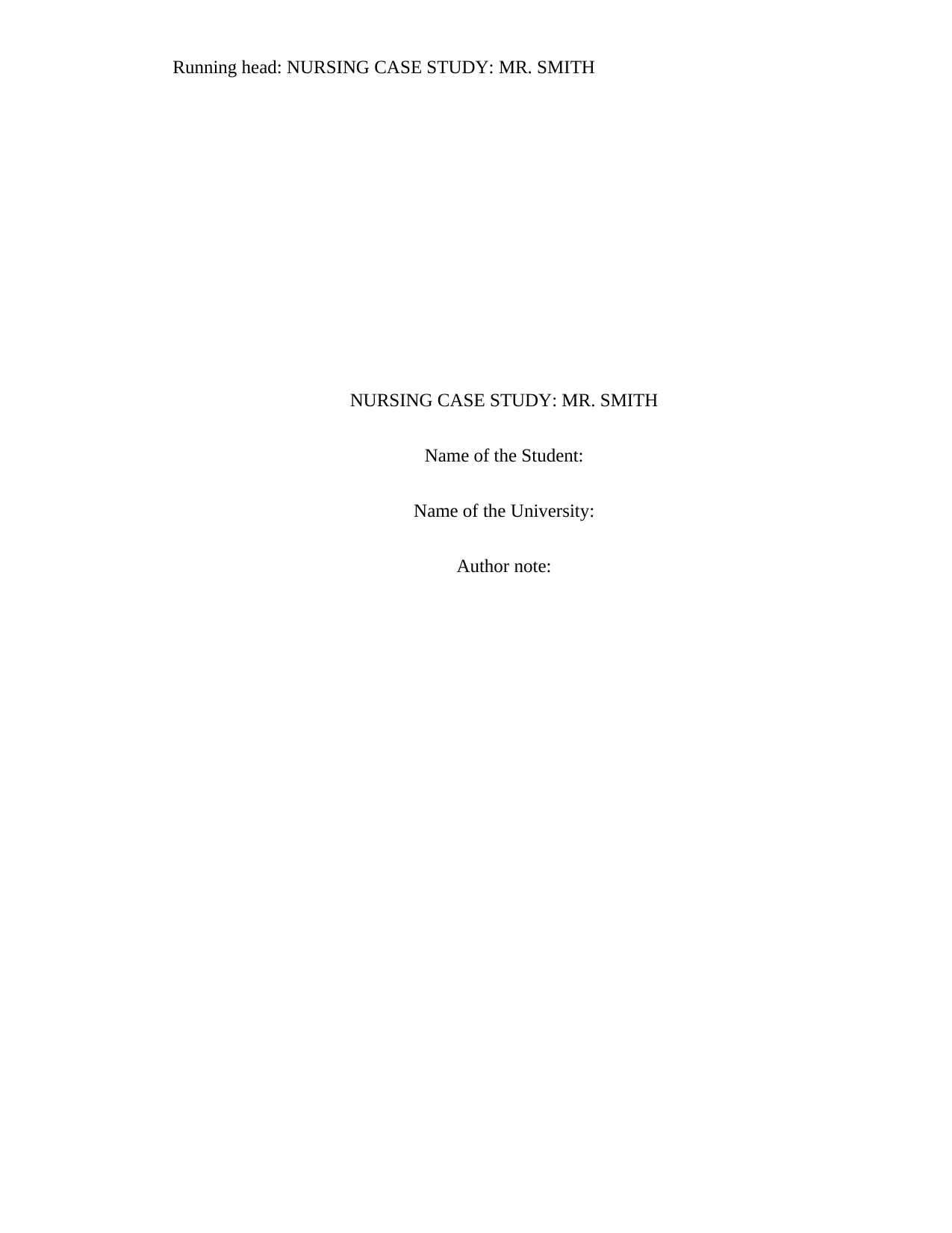
Running head: NURSING CASE STUDY: MR. SMITH
NURSING CASE STUDY: MR. SMITH
Name of the Student:
Name of the University:
Author note:
NURSING CASE STUDY: MR. SMITH
Name of the Student:
Name of the University:
Author note:
Paraphrase This Document
Need a fresh take? Get an instant paraphrase of this document with our AI Paraphraser
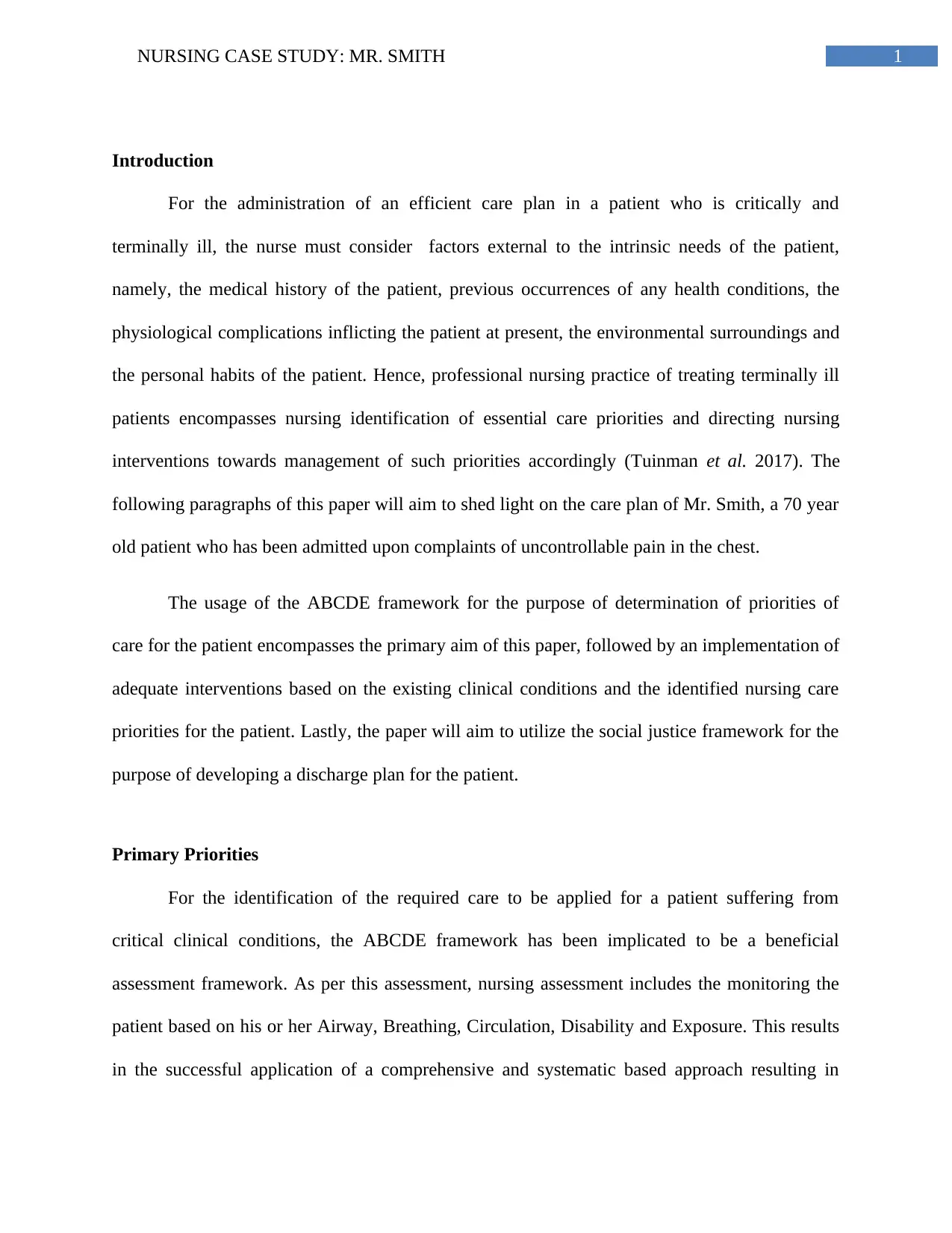
1NURSING CASE STUDY: MR. SMITH
Introduction
For the administration of an efficient care plan in a patient who is critically and
terminally ill, the nurse must consider factors external to the intrinsic needs of the patient,
namely, the medical history of the patient, previous occurrences of any health conditions, the
physiological complications inflicting the patient at present, the environmental surroundings and
the personal habits of the patient. Hence, professional nursing practice of treating terminally ill
patients encompasses nursing identification of essential care priorities and directing nursing
interventions towards management of such priorities accordingly (Tuinman et al. 2017). The
following paragraphs of this paper will aim to shed light on the care plan of Mr. Smith, a 70 year
old patient who has been admitted upon complaints of uncontrollable pain in the chest.
The usage of the ABCDE framework for the purpose of determination of priorities of
care for the patient encompasses the primary aim of this paper, followed by an implementation of
adequate interventions based on the existing clinical conditions and the identified nursing care
priorities for the patient. Lastly, the paper will aim to utilize the social justice framework for the
purpose of developing a discharge plan for the patient.
Primary Priorities
For the identification of the required care to be applied for a patient suffering from
critical clinical conditions, the ABCDE framework has been implicated to be a beneficial
assessment framework. As per this assessment, nursing assessment includes the monitoring the
patient based on his or her Airway, Breathing, Circulation, Disability and Exposure. This results
in the successful application of a comprehensive and systematic based approach resulting in
Introduction
For the administration of an efficient care plan in a patient who is critically and
terminally ill, the nurse must consider factors external to the intrinsic needs of the patient,
namely, the medical history of the patient, previous occurrences of any health conditions, the
physiological complications inflicting the patient at present, the environmental surroundings and
the personal habits of the patient. Hence, professional nursing practice of treating terminally ill
patients encompasses nursing identification of essential care priorities and directing nursing
interventions towards management of such priorities accordingly (Tuinman et al. 2017). The
following paragraphs of this paper will aim to shed light on the care plan of Mr. Smith, a 70 year
old patient who has been admitted upon complaints of uncontrollable pain in the chest.
The usage of the ABCDE framework for the purpose of determination of priorities of
care for the patient encompasses the primary aim of this paper, followed by an implementation of
adequate interventions based on the existing clinical conditions and the identified nursing care
priorities for the patient. Lastly, the paper will aim to utilize the social justice framework for the
purpose of developing a discharge plan for the patient.
Primary Priorities
For the identification of the required care to be applied for a patient suffering from
critical clinical conditions, the ABCDE framework has been implicated to be a beneficial
assessment framework. As per this assessment, nursing assessment includes the monitoring the
patient based on his or her Airway, Breathing, Circulation, Disability and Exposure. This results
in the successful application of a comprehensive and systematic based approach resulting in
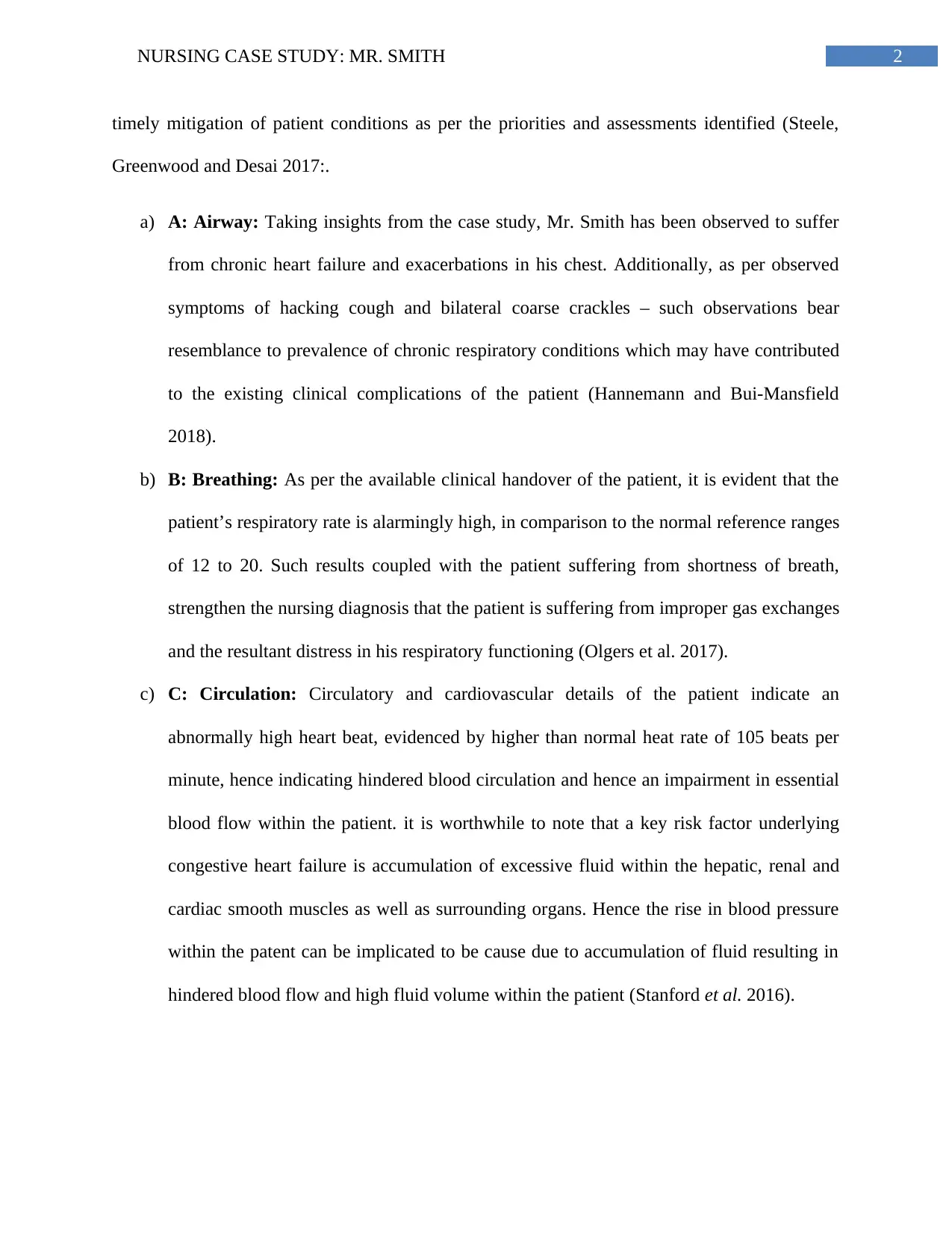
2NURSING CASE STUDY: MR. SMITH
timely mitigation of patient conditions as per the priorities and assessments identified (Steele,
Greenwood and Desai 2017:.
a) A: Airway: Taking insights from the case study, Mr. Smith has been observed to suffer
from chronic heart failure and exacerbations in his chest. Additionally, as per observed
symptoms of hacking cough and bilateral coarse crackles – such observations bear
resemblance to prevalence of chronic respiratory conditions which may have contributed
to the existing clinical complications of the patient (Hannemann and Bui-Mansfield
2018).
b) B: Breathing: As per the available clinical handover of the patient, it is evident that the
patient’s respiratory rate is alarmingly high, in comparison to the normal reference ranges
of 12 to 20. Such results coupled with the patient suffering from shortness of breath,
strengthen the nursing diagnosis that the patient is suffering from improper gas exchanges
and the resultant distress in his respiratory functioning (Olgers et al. 2017).
c) C: Circulation: Circulatory and cardiovascular details of the patient indicate an
abnormally high heart beat, evidenced by higher than normal heat rate of 105 beats per
minute, hence indicating hindered blood circulation and hence an impairment in essential
blood flow within the patient. it is worthwhile to note that a key risk factor underlying
congestive heart failure is accumulation of excessive fluid within the hepatic, renal and
cardiac smooth muscles as well as surrounding organs. Hence the rise in blood pressure
within the patent can be implicated to be cause due to accumulation of fluid resulting in
hindered blood flow and high fluid volume within the patient (Stanford et al. 2016).
timely mitigation of patient conditions as per the priorities and assessments identified (Steele,
Greenwood and Desai 2017:.
a) A: Airway: Taking insights from the case study, Mr. Smith has been observed to suffer
from chronic heart failure and exacerbations in his chest. Additionally, as per observed
symptoms of hacking cough and bilateral coarse crackles – such observations bear
resemblance to prevalence of chronic respiratory conditions which may have contributed
to the existing clinical complications of the patient (Hannemann and Bui-Mansfield
2018).
b) B: Breathing: As per the available clinical handover of the patient, it is evident that the
patient’s respiratory rate is alarmingly high, in comparison to the normal reference ranges
of 12 to 20. Such results coupled with the patient suffering from shortness of breath,
strengthen the nursing diagnosis that the patient is suffering from improper gas exchanges
and the resultant distress in his respiratory functioning (Olgers et al. 2017).
c) C: Circulation: Circulatory and cardiovascular details of the patient indicate an
abnormally high heart beat, evidenced by higher than normal heat rate of 105 beats per
minute, hence indicating hindered blood circulation and hence an impairment in essential
blood flow within the patient. it is worthwhile to note that a key risk factor underlying
congestive heart failure is accumulation of excessive fluid within the hepatic, renal and
cardiac smooth muscles as well as surrounding organs. Hence the rise in blood pressure
within the patent can be implicated to be cause due to accumulation of fluid resulting in
hindered blood flow and high fluid volume within the patient (Stanford et al. 2016).
⊘ This is a preview!⊘
Do you want full access?
Subscribe today to unlock all pages.

Trusted by 1+ million students worldwide

3NURSING CASE STUDY: MR. SMITH
d) D: Disability: The observed disability of the patient can be implicated with findings
indicating an abnormally low oxygen saturation of 92% which further indicates life
threatening condition of hypoxia (Norton 2017).
e) E: (Exposure): As per the available information, there was no indication of any form of
exposure.
Hence taking insights from the above assessment, it can be understood that two priorities
of care which must be considered by the nurse is the management of excessive fluid volume in
the body and mitigation of impairment in gas exchange. Hence, as per the same, the nurse and
allocated healthcare team will aim to monitor the patient’s intake of fluid and control
consumption of minerals like sodium for elimination of excessive body fluid. For the purpose of
managing impaired gas exchange, the nurse must aim to administer external sources of oxygen
and exercises for improved breathing (Buck et al. 2015).
Interventions
First Priority: Management of Excessive Fluid Volume
Intervention 1: Control of mineral intake
Pathophysiology
Congestive heart failure in patients is characterized by an increase in the accumulation of
fluid in tissues present in the vicinity. Congestive heart failure results in weakening of the
muscles in the lower ventricle, resulting in reduce cardiac functioning of circulating blood to
every organ of the body (Miller 2016). This results in deprivation of essential nutrients and
oxygen within the organs which further leads to exertion of compensatory mechanism of
d) D: Disability: The observed disability of the patient can be implicated with findings
indicating an abnormally low oxygen saturation of 92% which further indicates life
threatening condition of hypoxia (Norton 2017).
e) E: (Exposure): As per the available information, there was no indication of any form of
exposure.
Hence taking insights from the above assessment, it can be understood that two priorities
of care which must be considered by the nurse is the management of excessive fluid volume in
the body and mitigation of impairment in gas exchange. Hence, as per the same, the nurse and
allocated healthcare team will aim to monitor the patient’s intake of fluid and control
consumption of minerals like sodium for elimination of excessive body fluid. For the purpose of
managing impaired gas exchange, the nurse must aim to administer external sources of oxygen
and exercises for improved breathing (Buck et al. 2015).
Interventions
First Priority: Management of Excessive Fluid Volume
Intervention 1: Control of mineral intake
Pathophysiology
Congestive heart failure in patients is characterized by an increase in the accumulation of
fluid in tissues present in the vicinity. Congestive heart failure results in weakening of the
muscles in the lower ventricle, resulting in reduce cardiac functioning of circulating blood to
every organ of the body (Miller 2016). This results in deprivation of essential nutrients and
oxygen within the organs which further leads to exertion of compensatory mechanism of
Paraphrase This Document
Need a fresh take? Get an instant paraphrase of this document with our AI Paraphraser
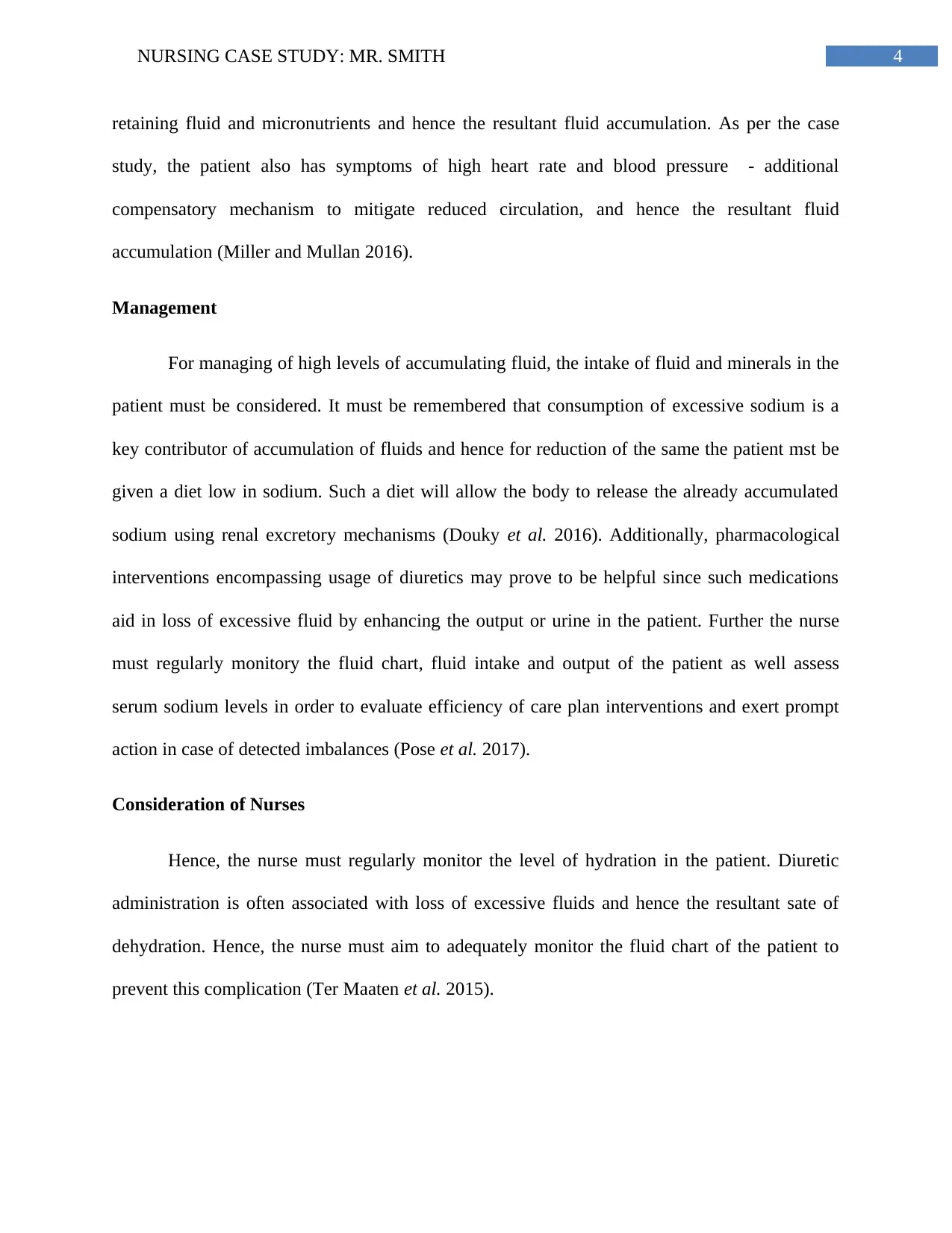
4NURSING CASE STUDY: MR. SMITH
retaining fluid and micronutrients and hence the resultant fluid accumulation. As per the case
study, the patient also has symptoms of high heart rate and blood pressure - additional
compensatory mechanism to mitigate reduced circulation, and hence the resultant fluid
accumulation (Miller and Mullan 2016).
Management
For managing of high levels of accumulating fluid, the intake of fluid and minerals in the
patient must be considered. It must be remembered that consumption of excessive sodium is a
key contributor of accumulation of fluids and hence for reduction of the same the patient mst be
given a diet low in sodium. Such a diet will allow the body to release the already accumulated
sodium using renal excretory mechanisms (Douky et al. 2016). Additionally, pharmacological
interventions encompassing usage of diuretics may prove to be helpful since such medications
aid in loss of excessive fluid by enhancing the output or urine in the patient. Further the nurse
must regularly monitory the fluid chart, fluid intake and output of the patient as well assess
serum sodium levels in order to evaluate efficiency of care plan interventions and exert prompt
action in case of detected imbalances (Pose et al. 2017).
Consideration of Nurses
Hence, the nurse must regularly monitor the level of hydration in the patient. Diuretic
administration is often associated with loss of excessive fluids and hence the resultant sate of
dehydration. Hence, the nurse must aim to adequately monitor the fluid chart of the patient to
prevent this complication (Ter Maaten et al. 2015).
retaining fluid and micronutrients and hence the resultant fluid accumulation. As per the case
study, the patient also has symptoms of high heart rate and blood pressure - additional
compensatory mechanism to mitigate reduced circulation, and hence the resultant fluid
accumulation (Miller and Mullan 2016).
Management
For managing of high levels of accumulating fluid, the intake of fluid and minerals in the
patient must be considered. It must be remembered that consumption of excessive sodium is a
key contributor of accumulation of fluids and hence for reduction of the same the patient mst be
given a diet low in sodium. Such a diet will allow the body to release the already accumulated
sodium using renal excretory mechanisms (Douky et al. 2016). Additionally, pharmacological
interventions encompassing usage of diuretics may prove to be helpful since such medications
aid in loss of excessive fluid by enhancing the output or urine in the patient. Further the nurse
must regularly monitory the fluid chart, fluid intake and output of the patient as well assess
serum sodium levels in order to evaluate efficiency of care plan interventions and exert prompt
action in case of detected imbalances (Pose et al. 2017).
Consideration of Nurses
Hence, the nurse must regularly monitor the level of hydration in the patient. Diuretic
administration is often associated with loss of excessive fluids and hence the resultant sate of
dehydration. Hence, the nurse must aim to adequately monitor the fluid chart of the patient to
prevent this complication (Ter Maaten et al. 2015).
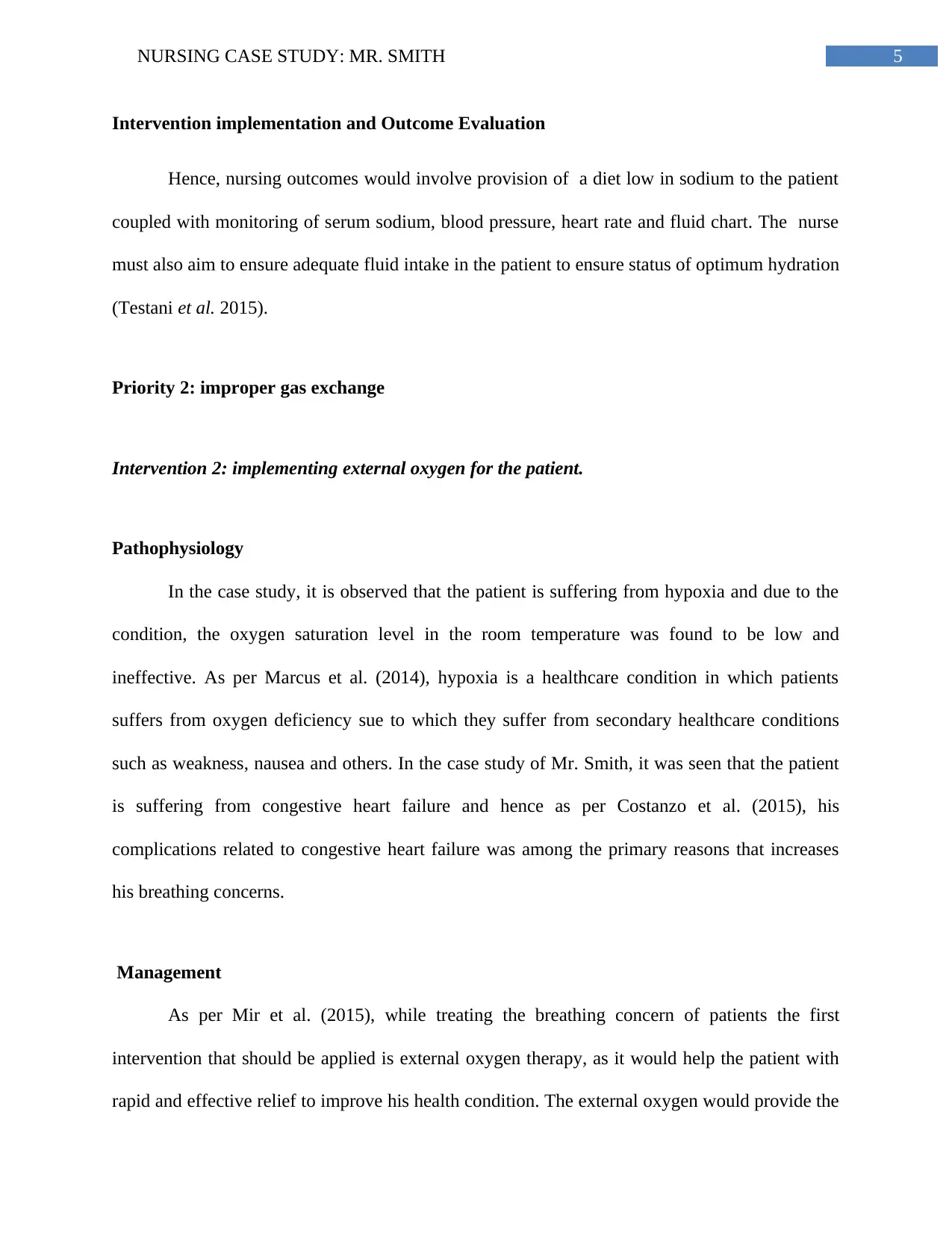
5NURSING CASE STUDY: MR. SMITH
Intervention implementation and Outcome Evaluation
Hence, nursing outcomes would involve provision of a diet low in sodium to the patient
coupled with monitoring of serum sodium, blood pressure, heart rate and fluid chart. The nurse
must also aim to ensure adequate fluid intake in the patient to ensure status of optimum hydration
(Testani et al. 2015).
Priority 2: improper gas exchange
Intervention 2: implementing external oxygen for the patient.
Pathophysiology
In the case study, it is observed that the patient is suffering from hypoxia and due to the
condition, the oxygen saturation level in the room temperature was found to be low and
ineffective. As per Marcus et al. (2014), hypoxia is a healthcare condition in which patients
suffers from oxygen deficiency sue to which they suffer from secondary healthcare conditions
such as weakness, nausea and others. In the case study of Mr. Smith, it was seen that the patient
is suffering from congestive heart failure and hence as per Costanzo et al. (2015), his
complications related to congestive heart failure was among the primary reasons that increases
his breathing concerns.
Management
As per Mir et al. (2015), while treating the breathing concern of patients the first
intervention that should be applied is external oxygen therapy, as it would help the patient with
rapid and effective relief to improve his health condition. The external oxygen would provide the
Intervention implementation and Outcome Evaluation
Hence, nursing outcomes would involve provision of a diet low in sodium to the patient
coupled with monitoring of serum sodium, blood pressure, heart rate and fluid chart. The nurse
must also aim to ensure adequate fluid intake in the patient to ensure status of optimum hydration
(Testani et al. 2015).
Priority 2: improper gas exchange
Intervention 2: implementing external oxygen for the patient.
Pathophysiology
In the case study, it is observed that the patient is suffering from hypoxia and due to the
condition, the oxygen saturation level in the room temperature was found to be low and
ineffective. As per Marcus et al. (2014), hypoxia is a healthcare condition in which patients
suffers from oxygen deficiency sue to which they suffer from secondary healthcare conditions
such as weakness, nausea and others. In the case study of Mr. Smith, it was seen that the patient
is suffering from congestive heart failure and hence as per Costanzo et al. (2015), his
complications related to congestive heart failure was among the primary reasons that increases
his breathing concerns.
Management
As per Mir et al. (2015), while treating the breathing concern of patients the first
intervention that should be applied is external oxygen therapy, as it would help the patient with
rapid and effective relief to improve his health condition. The external oxygen would provide the
⊘ This is a preview!⊘
Do you want full access?
Subscribe today to unlock all pages.

Trusted by 1+ million students worldwide
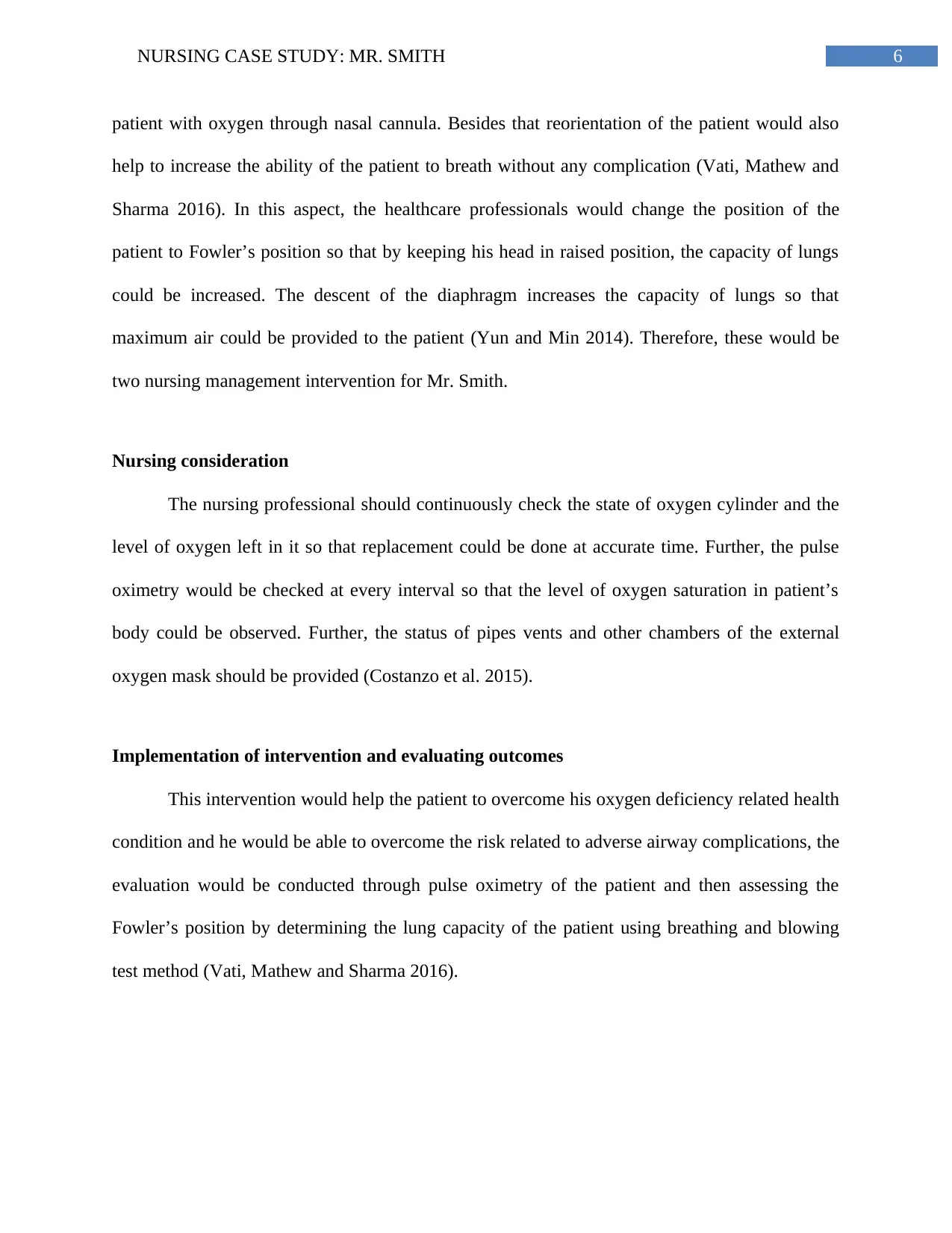
6NURSING CASE STUDY: MR. SMITH
patient with oxygen through nasal cannula. Besides that reorientation of the patient would also
help to increase the ability of the patient to breath without any complication (Vati, Mathew and
Sharma 2016). In this aspect, the healthcare professionals would change the position of the
patient to Fowler’s position so that by keeping his head in raised position, the capacity of lungs
could be increased. The descent of the diaphragm increases the capacity of lungs so that
maximum air could be provided to the patient (Yun and Min 2014). Therefore, these would be
two nursing management intervention for Mr. Smith.
Nursing consideration
The nursing professional should continuously check the state of oxygen cylinder and the
level of oxygen left in it so that replacement could be done at accurate time. Further, the pulse
oximetry would be checked at every interval so that the level of oxygen saturation in patient’s
body could be observed. Further, the status of pipes vents and other chambers of the external
oxygen mask should be provided (Costanzo et al. 2015).
Implementation of intervention and evaluating outcomes
This intervention would help the patient to overcome his oxygen deficiency related health
condition and he would be able to overcome the risk related to adverse airway complications, the
evaluation would be conducted through pulse oximetry of the patient and then assessing the
Fowler’s position by determining the lung capacity of the patient using breathing and blowing
test method (Vati, Mathew and Sharma 2016).
patient with oxygen through nasal cannula. Besides that reorientation of the patient would also
help to increase the ability of the patient to breath without any complication (Vati, Mathew and
Sharma 2016). In this aspect, the healthcare professionals would change the position of the
patient to Fowler’s position so that by keeping his head in raised position, the capacity of lungs
could be increased. The descent of the diaphragm increases the capacity of lungs so that
maximum air could be provided to the patient (Yun and Min 2014). Therefore, these would be
two nursing management intervention for Mr. Smith.
Nursing consideration
The nursing professional should continuously check the state of oxygen cylinder and the
level of oxygen left in it so that replacement could be done at accurate time. Further, the pulse
oximetry would be checked at every interval so that the level of oxygen saturation in patient’s
body could be observed. Further, the status of pipes vents and other chambers of the external
oxygen mask should be provided (Costanzo et al. 2015).
Implementation of intervention and evaluating outcomes
This intervention would help the patient to overcome his oxygen deficiency related health
condition and he would be able to overcome the risk related to adverse airway complications, the
evaluation would be conducted through pulse oximetry of the patient and then assessing the
Fowler’s position by determining the lung capacity of the patient using breathing and blowing
test method (Vati, Mathew and Sharma 2016).
Paraphrase This Document
Need a fresh take? Get an instant paraphrase of this document with our AI Paraphraser

7NURSING CASE STUDY: MR. SMITH
Intervention 3: healthcare literacy about breathing exercises
Pathophysiology
Patient literacy is one of the curial and effective healthcare intervention, application of
which could increase the patient’s efficiency to the healthcare process and develops their
understanding about the healthcare interventions so that they could comply with the process
without the help of healthcare professionals (Brazzale, Pretto and Schachter 2015). Patients
suffering from bilateral bibasal coarse crackles and basal crackles should be provided with
breathing and airway exercises so that they could overcome the complications associated with
this health condition (Thomas and Bruton 2014). Hence, application of breathing and airway
exercises would help the patient to overcome the complication and his learning related to four
strategies of breathing in complicated health condition.
Management
The nursing education and physiotherapists would be included in the care process for this
intervention and the education would be provided for 4 weeks. Further, the four breathing
technique to treat her congestion related health condition would also be treated during this health
literacy intervention (Brazzale, Pretto and Schachter 2015).
Nursing consideration
The educator should assess and observe the posture and position of the patient while
going through the breathing and airway related exercise education sessions. As perBuchvald et
al. (2016), if the patient fails to maintain a proper position and perform s all the healthcare
Intervention 3: healthcare literacy about breathing exercises
Pathophysiology
Patient literacy is one of the curial and effective healthcare intervention, application of
which could increase the patient’s efficiency to the healthcare process and develops their
understanding about the healthcare interventions so that they could comply with the process
without the help of healthcare professionals (Brazzale, Pretto and Schachter 2015). Patients
suffering from bilateral bibasal coarse crackles and basal crackles should be provided with
breathing and airway exercises so that they could overcome the complications associated with
this health condition (Thomas and Bruton 2014). Hence, application of breathing and airway
exercises would help the patient to overcome the complication and his learning related to four
strategies of breathing in complicated health condition.
Management
The nursing education and physiotherapists would be included in the care process for this
intervention and the education would be provided for 4 weeks. Further, the four breathing
technique to treat her congestion related health condition would also be treated during this health
literacy intervention (Brazzale, Pretto and Schachter 2015).
Nursing consideration
The educator should assess and observe the posture and position of the patient while
going through the breathing and airway related exercise education sessions. As perBuchvald et
al. (2016), if the patient fails to maintain a proper position and perform s all the healthcare
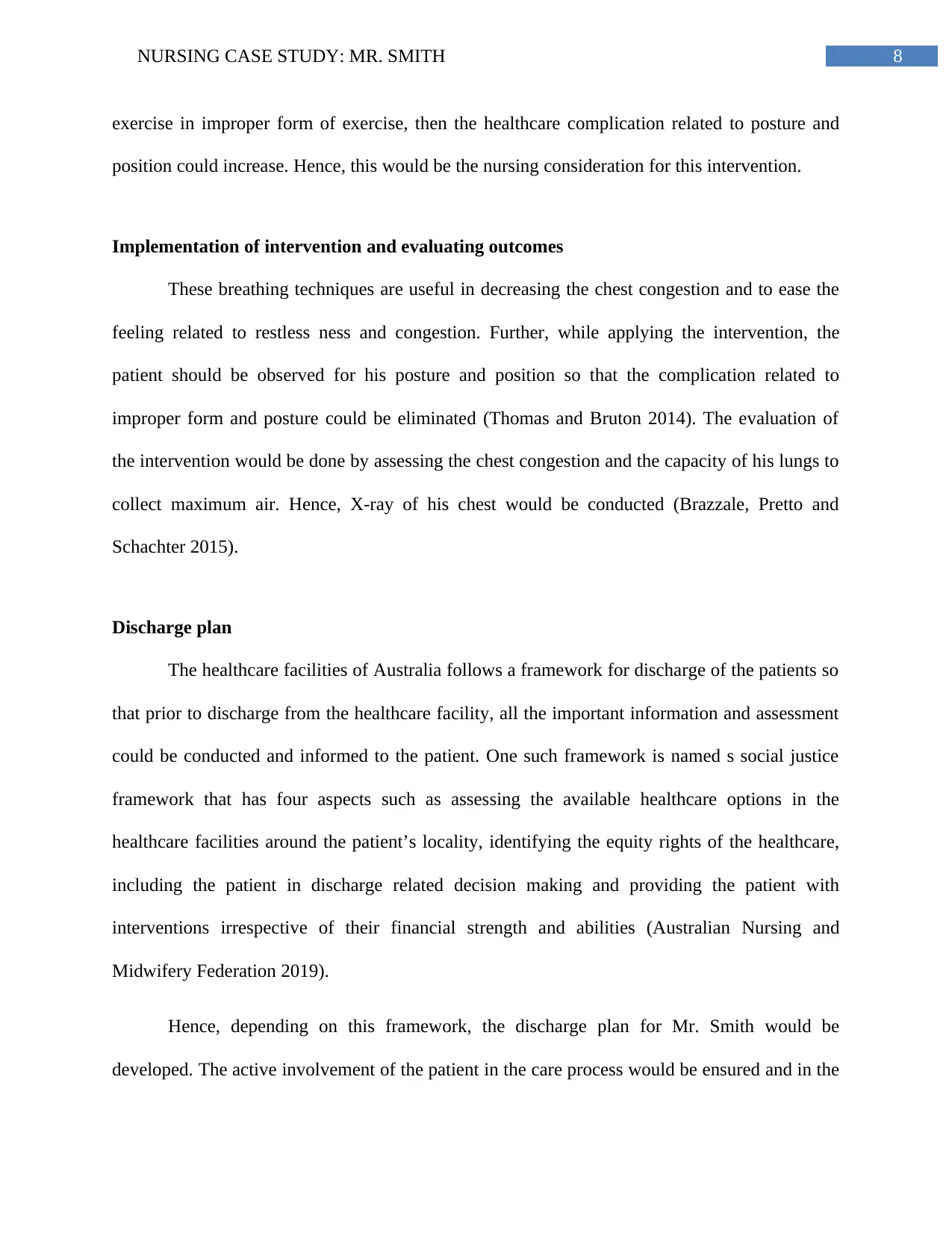
8NURSING CASE STUDY: MR. SMITH
exercise in improper form of exercise, then the healthcare complication related to posture and
position could increase. Hence, this would be the nursing consideration for this intervention.
Implementation of intervention and evaluating outcomes
These breathing techniques are useful in decreasing the chest congestion and to ease the
feeling related to restless ness and congestion. Further, while applying the intervention, the
patient should be observed for his posture and position so that the complication related to
improper form and posture could be eliminated (Thomas and Bruton 2014). The evaluation of
the intervention would be done by assessing the chest congestion and the capacity of his lungs to
collect maximum air. Hence, X-ray of his chest would be conducted (Brazzale, Pretto and
Schachter 2015).
Discharge plan
The healthcare facilities of Australia follows a framework for discharge of the patients so
that prior to discharge from the healthcare facility, all the important information and assessment
could be conducted and informed to the patient. One such framework is named s social justice
framework that has four aspects such as assessing the available healthcare options in the
healthcare facilities around the patient’s locality, identifying the equity rights of the healthcare,
including the patient in discharge related decision making and providing the patient with
interventions irrespective of their financial strength and abilities (Australian Nursing and
Midwifery Federation 2019).
Hence, depending on this framework, the discharge plan for Mr. Smith would be
developed. The active involvement of the patient in the care process would be ensured and in the
exercise in improper form of exercise, then the healthcare complication related to posture and
position could increase. Hence, this would be the nursing consideration for this intervention.
Implementation of intervention and evaluating outcomes
These breathing techniques are useful in decreasing the chest congestion and to ease the
feeling related to restless ness and congestion. Further, while applying the intervention, the
patient should be observed for his posture and position so that the complication related to
improper form and posture could be eliminated (Thomas and Bruton 2014). The evaluation of
the intervention would be done by assessing the chest congestion and the capacity of his lungs to
collect maximum air. Hence, X-ray of his chest would be conducted (Brazzale, Pretto and
Schachter 2015).
Discharge plan
The healthcare facilities of Australia follows a framework for discharge of the patients so
that prior to discharge from the healthcare facility, all the important information and assessment
could be conducted and informed to the patient. One such framework is named s social justice
framework that has four aspects such as assessing the available healthcare options in the
healthcare facilities around the patient’s locality, identifying the equity rights of the healthcare,
including the patient in discharge related decision making and providing the patient with
interventions irrespective of their financial strength and abilities (Australian Nursing and
Midwifery Federation 2019).
Hence, depending on this framework, the discharge plan for Mr. Smith would be
developed. The active involvement of the patient in the care process would be ensured and in the
⊘ This is a preview!⊘
Do you want full access?
Subscribe today to unlock all pages.

Trusted by 1+ million students worldwide
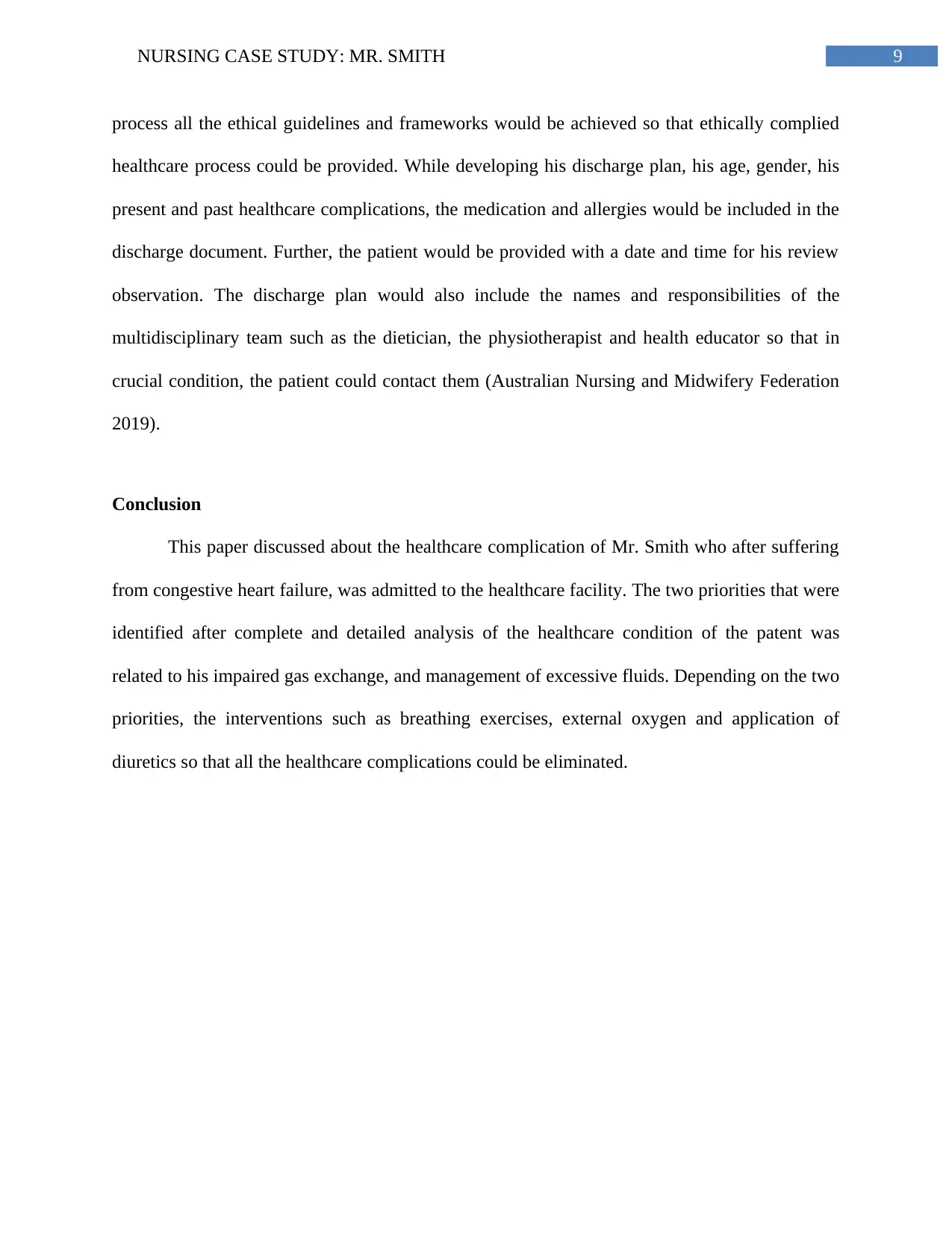
9NURSING CASE STUDY: MR. SMITH
process all the ethical guidelines and frameworks would be achieved so that ethically complied
healthcare process could be provided. While developing his discharge plan, his age, gender, his
present and past healthcare complications, the medication and allergies would be included in the
discharge document. Further, the patient would be provided with a date and time for his review
observation. The discharge plan would also include the names and responsibilities of the
multidisciplinary team such as the dietician, the physiotherapist and health educator so that in
crucial condition, the patient could contact them (Australian Nursing and Midwifery Federation
2019).
Conclusion
This paper discussed about the healthcare complication of Mr. Smith who after suffering
from congestive heart failure, was admitted to the healthcare facility. The two priorities that were
identified after complete and detailed analysis of the healthcare condition of the patent was
related to his impaired gas exchange, and management of excessive fluids. Depending on the two
priorities, the interventions such as breathing exercises, external oxygen and application of
diuretics so that all the healthcare complications could be eliminated.
process all the ethical guidelines and frameworks would be achieved so that ethically complied
healthcare process could be provided. While developing his discharge plan, his age, gender, his
present and past healthcare complications, the medication and allergies would be included in the
discharge document. Further, the patient would be provided with a date and time for his review
observation. The discharge plan would also include the names and responsibilities of the
multidisciplinary team such as the dietician, the physiotherapist and health educator so that in
crucial condition, the patient could contact them (Australian Nursing and Midwifery Federation
2019).
Conclusion
This paper discussed about the healthcare complication of Mr. Smith who after suffering
from congestive heart failure, was admitted to the healthcare facility. The two priorities that were
identified after complete and detailed analysis of the healthcare condition of the patent was
related to his impaired gas exchange, and management of excessive fluids. Depending on the two
priorities, the interventions such as breathing exercises, external oxygen and application of
diuretics so that all the healthcare complications could be eliminated.
Paraphrase This Document
Need a fresh take? Get an instant paraphrase of this document with our AI Paraphraser
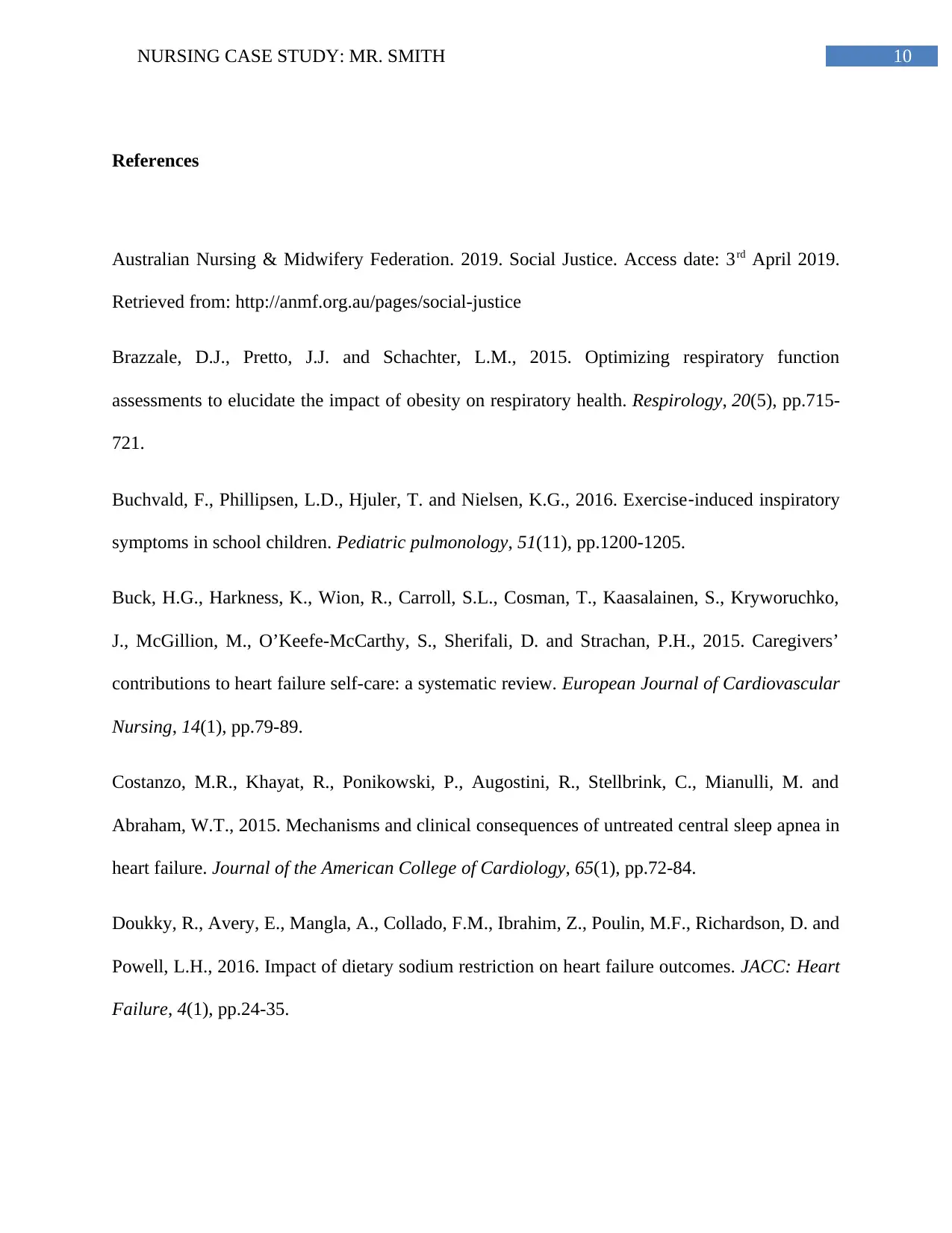
10NURSING CASE STUDY: MR. SMITH
References
Australian Nursing & Midwifery Federation. 2019. Social Justice. Access date: 3rd April 2019.
Retrieved from: http://anmf.org.au/pages/social-justice
Brazzale, D.J., Pretto, J.J. and Schachter, L.M., 2015. Optimizing respiratory function
assessments to elucidate the impact of obesity on respiratory health. Respirology, 20(5), pp.715-
721.
Buchvald, F., Phillipsen, L.D., Hjuler, T. and Nielsen, K.G., 2016. Exercise‐induced inspiratory
symptoms in school children. Pediatric pulmonology, 51(11), pp.1200-1205.
Buck, H.G., Harkness, K., Wion, R., Carroll, S.L., Cosman, T., Kaasalainen, S., Kryworuchko,
J., McGillion, M., O’Keefe-McCarthy, S., Sherifali, D. and Strachan, P.H., 2015. Caregivers’
contributions to heart failure self-care: a systematic review. European Journal of Cardiovascular
Nursing, 14(1), pp.79-89.
Costanzo, M.R., Khayat, R., Ponikowski, P., Augostini, R., Stellbrink, C., Mianulli, M. and
Abraham, W.T., 2015. Mechanisms and clinical consequences of untreated central sleep apnea in
heart failure. Journal of the American College of Cardiology, 65(1), pp.72-84.
Doukky, R., Avery, E., Mangla, A., Collado, F.M., Ibrahim, Z., Poulin, M.F., Richardson, D. and
Powell, L.H., 2016. Impact of dietary sodium restriction on heart failure outcomes. JACC: Heart
Failure, 4(1), pp.24-35.
References
Australian Nursing & Midwifery Federation. 2019. Social Justice. Access date: 3rd April 2019.
Retrieved from: http://anmf.org.au/pages/social-justice
Brazzale, D.J., Pretto, J.J. and Schachter, L.M., 2015. Optimizing respiratory function
assessments to elucidate the impact of obesity on respiratory health. Respirology, 20(5), pp.715-
721.
Buchvald, F., Phillipsen, L.D., Hjuler, T. and Nielsen, K.G., 2016. Exercise‐induced inspiratory
symptoms in school children. Pediatric pulmonology, 51(11), pp.1200-1205.
Buck, H.G., Harkness, K., Wion, R., Carroll, S.L., Cosman, T., Kaasalainen, S., Kryworuchko,
J., McGillion, M., O’Keefe-McCarthy, S., Sherifali, D. and Strachan, P.H., 2015. Caregivers’
contributions to heart failure self-care: a systematic review. European Journal of Cardiovascular
Nursing, 14(1), pp.79-89.
Costanzo, M.R., Khayat, R., Ponikowski, P., Augostini, R., Stellbrink, C., Mianulli, M. and
Abraham, W.T., 2015. Mechanisms and clinical consequences of untreated central sleep apnea in
heart failure. Journal of the American College of Cardiology, 65(1), pp.72-84.
Doukky, R., Avery, E., Mangla, A., Collado, F.M., Ibrahim, Z., Poulin, M.F., Richardson, D. and
Powell, L.H., 2016. Impact of dietary sodium restriction on heart failure outcomes. JACC: Heart
Failure, 4(1), pp.24-35.
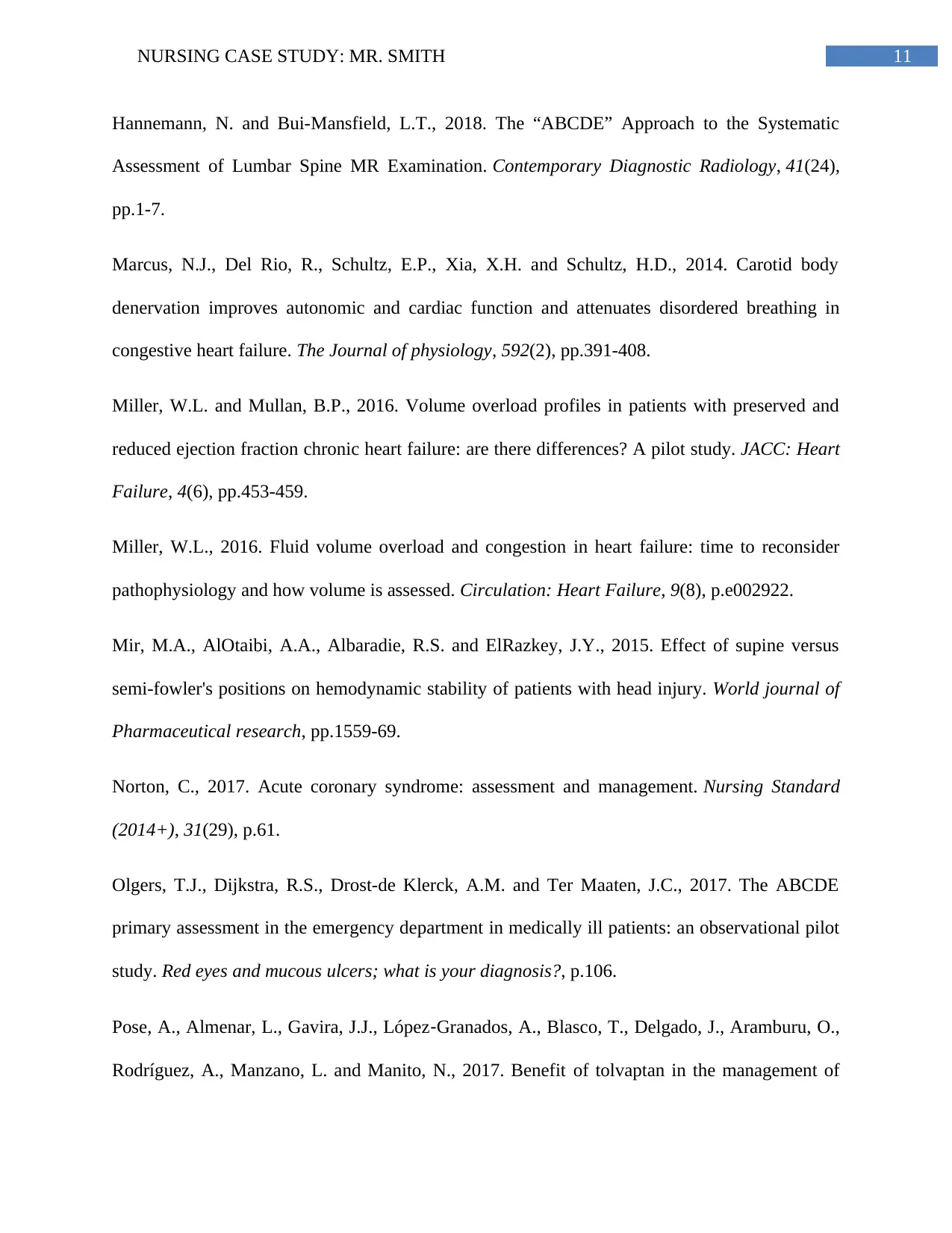
11NURSING CASE STUDY: MR. SMITH
Hannemann, N. and Bui-Mansfield, L.T., 2018. The “ABCDE” Approach to the Systematic
Assessment of Lumbar Spine MR Examination. Contemporary Diagnostic Radiology, 41(24),
pp.1-7.
Marcus, N.J., Del Rio, R., Schultz, E.P., Xia, X.H. and Schultz, H.D., 2014. Carotid body
denervation improves autonomic and cardiac function and attenuates disordered breathing in
congestive heart failure. The Journal of physiology, 592(2), pp.391-408.
Miller, W.L. and Mullan, B.P., 2016. Volume overload profiles in patients with preserved and
reduced ejection fraction chronic heart failure: are there differences? A pilot study. JACC: Heart
Failure, 4(6), pp.453-459.
Miller, W.L., 2016. Fluid volume overload and congestion in heart failure: time to reconsider
pathophysiology and how volume is assessed. Circulation: Heart Failure, 9(8), p.e002922.
Mir, M.A., AlOtaibi, A.A., Albaradie, R.S. and ElRazkey, J.Y., 2015. Effect of supine versus
semi-fowler's positions on hemodynamic stability of patients with head injury. World journal of
Pharmaceutical research, pp.1559-69.
Norton, C., 2017. Acute coronary syndrome: assessment and management. Nursing Standard
(2014+), 31(29), p.61.
Olgers, T.J., Dijkstra, R.S., Drost-de Klerck, A.M. and Ter Maaten, J.C., 2017. The ABCDE
primary assessment in the emergency department in medically ill patients: an observational pilot
study. Red eyes and mucous ulcers; what is your diagnosis?, p.106.
Pose, A., Almenar, L., Gavira, J.J., López‐Granados, A., Blasco, T., Delgado, J., Aramburu, O.,
Rodríguez, A., Manzano, L. and Manito, N., 2017. Benefit of tolvaptan in the management of
Hannemann, N. and Bui-Mansfield, L.T., 2018. The “ABCDE” Approach to the Systematic
Assessment of Lumbar Spine MR Examination. Contemporary Diagnostic Radiology, 41(24),
pp.1-7.
Marcus, N.J., Del Rio, R., Schultz, E.P., Xia, X.H. and Schultz, H.D., 2014. Carotid body
denervation improves autonomic and cardiac function and attenuates disordered breathing in
congestive heart failure. The Journal of physiology, 592(2), pp.391-408.
Miller, W.L. and Mullan, B.P., 2016. Volume overload profiles in patients with preserved and
reduced ejection fraction chronic heart failure: are there differences? A pilot study. JACC: Heart
Failure, 4(6), pp.453-459.
Miller, W.L., 2016. Fluid volume overload and congestion in heart failure: time to reconsider
pathophysiology and how volume is assessed. Circulation: Heart Failure, 9(8), p.e002922.
Mir, M.A., AlOtaibi, A.A., Albaradie, R.S. and ElRazkey, J.Y., 2015. Effect of supine versus
semi-fowler's positions on hemodynamic stability of patients with head injury. World journal of
Pharmaceutical research, pp.1559-69.
Norton, C., 2017. Acute coronary syndrome: assessment and management. Nursing Standard
(2014+), 31(29), p.61.
Olgers, T.J., Dijkstra, R.S., Drost-de Klerck, A.M. and Ter Maaten, J.C., 2017. The ABCDE
primary assessment in the emergency department in medically ill patients: an observational pilot
study. Red eyes and mucous ulcers; what is your diagnosis?, p.106.
Pose, A., Almenar, L., Gavira, J.J., López‐Granados, A., Blasco, T., Delgado, J., Aramburu, O.,
Rodríguez, A., Manzano, L. and Manito, N., 2017. Benefit of tolvaptan in the management of
⊘ This is a preview!⊘
Do you want full access?
Subscribe today to unlock all pages.

Trusted by 1+ million students worldwide

12NURSING CASE STUDY: MR. SMITH
hyponatraemia in patients with diuretic‐refractory congestive heart failure: the SEMI‐SEC
project. ESC heart failure, 4(2), pp.130-137.
Stanford, P., Booth, N., Suckley, J., Twelvetree, T. and Thomas, D., 2016. Assessment of injury
severity in patients with major trauma. Nursing Standard, 30(49).
Steele, A., Greenwood, M. and Desai, H., 2017. ABCDE assessment and the out-of-hospital
cardiac arrest. Dental Update, 44(10), pp.1003-1009.
Ter Maaten, J.M., Valente, M.A., Damman, K., Hillege, H.L., Navis, G. and Voors, A.A., 2015.
Diuretic response in acute heart failure—pathophysiology, evaluation, and therapy. Nature
Reviews Cardiology, 12(3), p.184.
Testani, J.M., Brisco, M.A., Kociol, R.D., Jacoby, D., Bellumkonda, L., Parikh, C.R., Coca, S.G.
and Tang, W.W., 2015. Substantial discrepancy between fluid and weight loss during acute
decompensated heart failure treatment. The American journal of medicine, 128(7), pp.776-783.
Thomas, M. and Bruton, A., 2014. Breathing exercises for asthma. Breathe, 10(4), pp.312-322.
Tuinman, A., de Greef, M.H., Krijnen, W.P., Paans, W. and Roodbol, P.F., 2017. Accuracy of
documentation in the nursing care plan in long-term institutional care. Geriatric Nursing, 38(6),
pp.578-583.
Vati, J., Mathew, T.K. and Sharma, Y.P., 2016. Effect Of Low Fowler's Position On Back Pain
And Vascular Complications Following Trans-Femoral Cardiac Catheterization: A Randomized
Controlled Trial. i-Manager's Journal on Nursing, 6(1), p.24.
Yun, M.J. and Min, H.S., 2014. The Effects of Position Change on Low Back Pain, Discomfort,
and Bleeding after Transarterial Chemoembolization. Korean Journal of Adult Nursing, 26(4).
hyponatraemia in patients with diuretic‐refractory congestive heart failure: the SEMI‐SEC
project. ESC heart failure, 4(2), pp.130-137.
Stanford, P., Booth, N., Suckley, J., Twelvetree, T. and Thomas, D., 2016. Assessment of injury
severity in patients with major trauma. Nursing Standard, 30(49).
Steele, A., Greenwood, M. and Desai, H., 2017. ABCDE assessment and the out-of-hospital
cardiac arrest. Dental Update, 44(10), pp.1003-1009.
Ter Maaten, J.M., Valente, M.A., Damman, K., Hillege, H.L., Navis, G. and Voors, A.A., 2015.
Diuretic response in acute heart failure—pathophysiology, evaluation, and therapy. Nature
Reviews Cardiology, 12(3), p.184.
Testani, J.M., Brisco, M.A., Kociol, R.D., Jacoby, D., Bellumkonda, L., Parikh, C.R., Coca, S.G.
and Tang, W.W., 2015. Substantial discrepancy between fluid and weight loss during acute
decompensated heart failure treatment. The American journal of medicine, 128(7), pp.776-783.
Thomas, M. and Bruton, A., 2014. Breathing exercises for asthma. Breathe, 10(4), pp.312-322.
Tuinman, A., de Greef, M.H., Krijnen, W.P., Paans, W. and Roodbol, P.F., 2017. Accuracy of
documentation in the nursing care plan in long-term institutional care. Geriatric Nursing, 38(6),
pp.578-583.
Vati, J., Mathew, T.K. and Sharma, Y.P., 2016. Effect Of Low Fowler's Position On Back Pain
And Vascular Complications Following Trans-Femoral Cardiac Catheterization: A Randomized
Controlled Trial. i-Manager's Journal on Nursing, 6(1), p.24.
Yun, M.J. and Min, H.S., 2014. The Effects of Position Change on Low Back Pain, Discomfort,
and Bleeding after Transarterial Chemoembolization. Korean Journal of Adult Nursing, 26(4).
1 out of 13
Related Documents
Your All-in-One AI-Powered Toolkit for Academic Success.
+13062052269
info@desklib.com
Available 24*7 on WhatsApp / Email
![[object Object]](/_next/static/media/star-bottom.7253800d.svg)
Unlock your academic potential
© 2024 | Zucol Services PVT LTD | All rights reserved.




